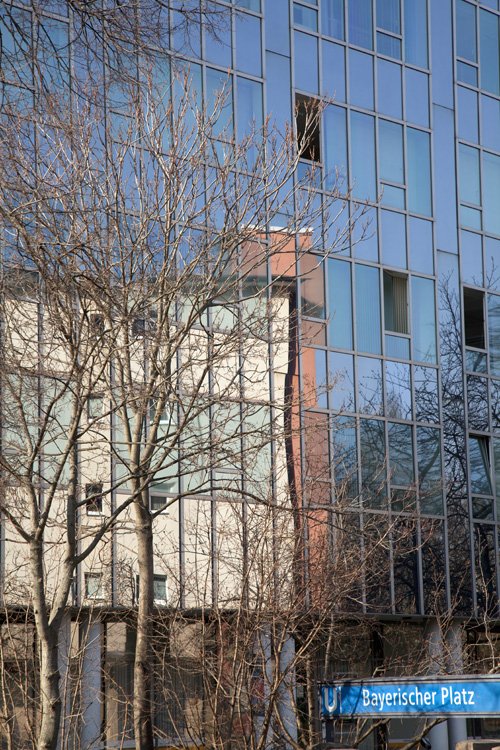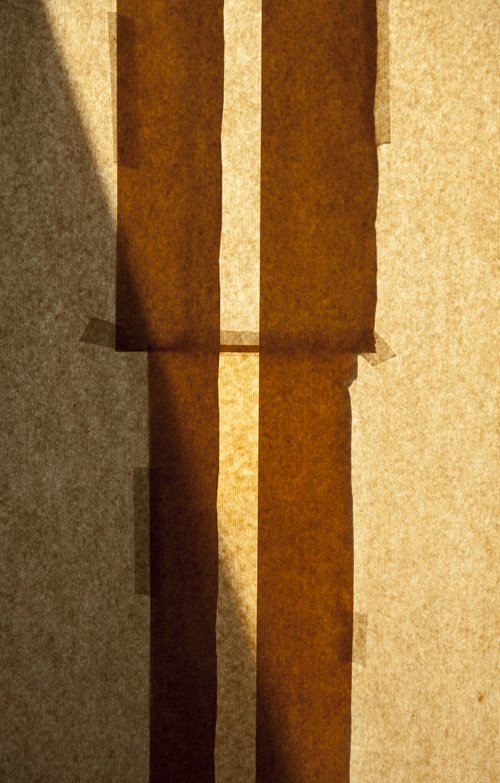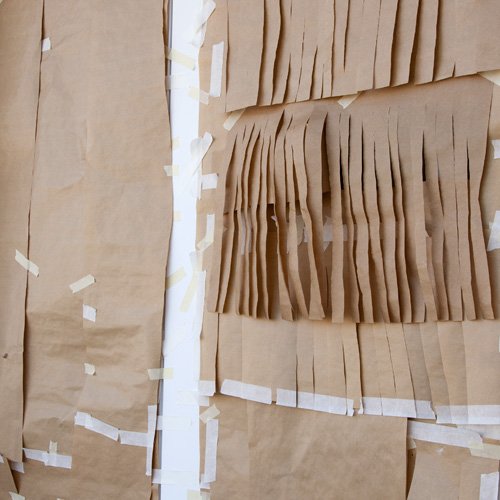Heatwave special: Heat and window glass

© Charlie Alice Raya
Starting point: Window glass heats up considerably when hit by direct sunlight. And glass needs longest to cool down after sunset (compared to the stone facade and the metal windowsill).
Question: Can the window glass be protected from the heat? And does this improve the temperature in the flat?
Experiments: Testing different methods of covering the windows, and observing the temperature of the glass.
Test objects: Three windows in the small room, two windows and the balcony door in the main room of my flat, in Berlin on the fifth floor, double glassing, synthetic window frames.
17 July 2022
Experiment 1
Balcony door (glass) covered from the outside with wrapping paper.

The other windows are only darkened from the inside (using some of my oil painting experiments).
Result
Wow. The difference in temperature, between the windows covered outside and those covered inside, was so significant that I covered most windows with packing paper that night.
Luckily my kitchen windows are to the north, so I still have a view.
18 July 2022, day 1 of the heatwave
Experiment 2
First day with fully covered windows. No fan, no air conditioning.
Result
Inconclusive because the sun rarely broke through the thin cloud cover. So the time of full sunshine-impact on my windows was limited.
This limited time indicated that some heating was still happening. And most of the day, I had cold feet while the temperatures outside climbed to 28º according to the weather app.
I started to get spooked or affected by not being able to look out. It had never worried me much when I covered the windows from the inside, basically sitting in darkness, but with light still coming through the brown paper– I wonder whether my subconscious couldn’t deal with the contradiction. At night, I finally gave in and took the paper off one window. And that helps a lot. It’s strange, but I feel like I can breathe more freely again.
More troubles: The adhesive tape I used is of poor quality. It dried in the heat, peeled off and parts of my construct had to be redone.
My additional task for tomorrow: Test whether a small window in the paper cover works, and if the heat on this exposed part of the window is insignificant because of the small size of the gap. And maybe it is possible to add more view gaps. The guess behind this approach is that for heat to gather it needs larger areas/surfaces, a small heated area doesn’t have the same effect as a whole heated windows. And that’s something for tinkerers, test how many view gaps you can include without reducing the benefits of avoiding direct sunlight. Maybe there could be a combination: a first layer with some gaps, a second layer made of stripes that can move in the wind and make sure that no gap gets direct sunlight permanently.
19 July 2022, day 2 of the heatwave
Experiment 3
Weather: temperatures are predicted to reach 33º or higher here in Berlin, today.
Present situation: It’s nearly eleven in the morning, the flat is cool, feet too, and one window is still uncovered. The sun gets to the balcony around two, so until then, I’ll leave the one window uncovered. I am considering to cut a little window into the cover later so that there is still a bit of sky visible from my desk.
It’s not the position of the sun that makes up all of the heat, air movements or the lack of it also plays a role, plus other factors, I guess.
Around 13:00 — Closed the kitchen window to keep warm air out.
14:02 — Put the paper up on the window and cut a little gap. So far the sun hasn’t reached the window. I’d say the exposed window is a tat warmer than the covered windows. But it’s so marginal that I can’t be sure. Very curious to see what happens next. It’s really hot outside and nicely cool in here (compared). I do sweat a little. No cold feet any more.
14:30 — Missed the moment, but now the lower quarter of the windows next to my writing desk get full sunlight. So far, there is no difference between window parts still in shadow and window parts in sunlight
14:52 — About half of the windows are hit by sunlight now. Still no noticeable difference in the temperature of the glass.
15:12 — The window parts with direct sunlight are warming a bit, except for the part that has a double layer of paper. The sun has reached the lower part of the gap. I wonder whether this window glass will heat more because more warm air gets between window and the brown paper.
The wind intensifies. That might pose a problem, since the paper isn’t fixed that securely. I don’t know how much wind my construct can take.
15:25 — Just lost a paper cover from a window in the small room. Took down the other two covers in that room, and will try another idea for fixing them, tonight. At the moment the air is too hot outside to let it in. Here in the main room, the covers seem to hold. Well, with the balcony, the paper won’t get lost even if it drops.
The good thing about this development is: now I have a direct comparison between the two window fronts, covered in my main room and uncovered in the small room.
15:51 — Boy it’s hot outside, 36º degree. And another bit of paper came down. It’s the adhesive tape that totally tries up in the heat. I used a more expensive one to fortify a few parts. But that tape is very old. So, I’m not sure whether it will do a better job. Very glad that my flat is this cool, compared.
Window heat test: No significant increase, except at the gap. I’m curious whether that heat will spread.
16:05 – Boy, again. It’s so hot outside. I decided to close the gap. It wasn’t the little patch of glass that decided me, but the sun hitting me and the floor.
Even though it was just a small gap, it still had a warming effect. I was just in time outside to further reinforce the paper. That cheap tape is nearly done. I think I’ll try something new tonight.
17:59 — Here is a puzzle. The two windows next to the balcony door are pretty warm by now. Not as hot at in the other room (no more paper cover) but much hotter than expected.
At the same time the balcony door is comparatively cool — and a good deal cooler than the windows. Parts of the balcony door have been in shadow much longer than the windows. Maybe that is one reason. Or maybe it has something to do with the form of the windows (shorter than the balcony door).
19:04 — The windows in both room are now pretty much the same temperature. Though luckily the temperature in the rooms is pleasant.
The balcony door is warm but still much cooler than the other windows. I’m starting to wonder whether that has something to do with the double layer of paper in the middle. Because in all cases the double layer protects the glass better from the heat, and maybe the middle strip break the area into smaller parts. What I mean is, maybe the window heats the most, the larger the surface. If the surface is broken by a cooler area, then the overall result is better?
20 July 2022, day 3 of the heatwave
Experiment 4
10:24 — It’s already 29º and I am sweating. This morning I put some ideas for an improved window covers in place.
Window 1 got an additional three broad stripes placed above the existing cover. The idea here is that maybe the balcony door stayed relatively cool because air can move between the various patches I used on the door.
For window 2 I worked with more patches and also with a variety of stripes.

There are several points I am interested in, today:
- Avoid any kind of large surface or break surfaces down into small entities to prevent heat from accumulating.
- Have more movement/air circulation due to the stripes and see what happens in areas where stripes overlap.
Present situation: Today quite a bit of warm air got into the flat, and I had the clever idea to cook rice (adding heat to the kitchen) so that it won’t be quite as pleasantly cool in here, today. However with some 38º predicted, it should still be pretty comfortable.
A note on last night: I fell asleep early and woke up in the middle of the night. It felt like the oxygen level was pretty low then. The oxygen level is a concern, and I wonder whether there is something that can be done about that inside. Would indoor plants have an effect?
13:24 — It’s 37º outside, and in here it’s pleasantly warm, even though I left the kitchen window open, today. The sun has not yet reached the windows and the glass is actually cool.
15:06 — Direct sunlight now hits two thirds of the windows. So far the window glass remains unheated, except for a small spot which only has one layer of paper and is in the lower part of the window, meaning it’s in a part with the longest sunlight contact.
So far there seems to be no difference between the areas with smaller stripes and with the broad stripes or other patches.
There is one observation which I could only verify properly if I had a way to measure the temperature of the glass. But it seems that the glass is slightly warmer along the boarder (where it connects to the frame). I’ll keep an eye on this.
Other than that, it’s 38º outside, and in here it’s pleasantly warm, no sweating or heaviness. Kitchen window is still open.
16:11 — Wow, still unchanged temperature as far as I can tell while the windows in the other room are hot.
18:22 — Booyah! The windows are still considerably less warm than the windows in the other room, and it’s still 36º outside.
I guess it’s the double layers plus breaking the surface and the fact that air gets to move around. The area with a single strip is hottest, but overlapping strips seems to work. Also, the earlier suspicion that the border of the glass was a little warmer, is now confirmed, and it is more apparent. It’s the black rubber or silicone. Though, I’m not sure why it warms up so much while the glass doesn’t. Is it the black or the material or both?
The multilayered window covers beat the balcony door, today. Though in both cases the glass is only moderately warm, and in no way comparable to the heat on the windows in the small room.
Conclusion
It is possible to prep a flat in a way that makes for a pleasant temperature, and that without the help of fans, air conditioning or total darkness. In fact, the light is a pleasant light, and the moving stripes have the added advantages that the room doesn’t appear to be as cut off from the outside world like on the first day of the experiments.
Image how much cooler any city or town would be if no windows let alone glass facades got direct sunlight.
The big question is: How can this be done in a way that the windows are only covered during direct sunlight?
And which materials can be used?
The paper worked well, but it can’t be removed easily and once removed it’s no fun to put it up again.
A vague thought keeps popping up. What if someone could develop a kind of sunblind or marquee for windows? But not with a single fixed surface but rather made of several layers of moving strips? Or maybe something like a mobile solar panel leaves curtain which can make use of the sunlight and which can be opened in the evening.
In any case, rethinking facades, windows and window covers should provide us with means to cool cities and towns.

back to: rethinking towns & cities
back to: rethinking facades
